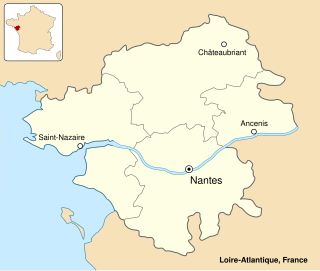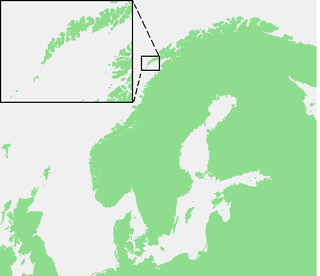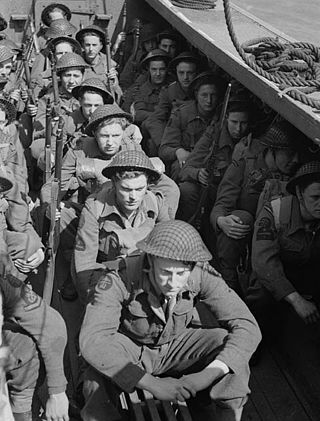Related Research Articles

A commando is a combatant, or operative of an elite light infantry or special operations force, specially trained for carrying out raids and operating in small teams behind enemy lines.

The St Nazaire Raid or Operation Chariot was a British amphibious attack on the heavily defended Normandie dry dock at St Nazaire in German-occupied France during the Second World War. The operation was undertaken by the Royal Navy (RN) and British Commandos under the auspices of Combined Operations Headquarters on 28 March 1942. St Nazaire was targeted because the loss of its dry dock would force any large German warship in need of repairs, such as Tirpitz, sister ship of Bismarck, to return to home waters by running the gauntlet of the Home Fleet of the Royal Navy and other British forces, via the English Channel or the North Sea.

The Commandos, also known as the British Commandos, were formed during the Second World War in June 1940, following a request from Winston Churchill, for special forces that could carry out raids against German-occupied Europe. Initially drawn from within the British Army from soldiers who volunteered for the Special Service Brigade, the Commandos' ranks would eventually be filled by members of all branches of the British Armed Forces and a number of foreign volunteers from German-occupied countries. By the end of the war 25,000 men had passed through the Commando course at Achnacarry. This total includes not only the British volunteers, but volunteers from Greece, France, Belgium, Netherlands, Canada, Norway, Poland, and the United States Army Rangers and US Marine Corps Raiders, Portuguese Fuzileiros Portuguese Marine Corps were modelled on the Commandos.
Operation Ambassador was an operation carried out by British Commandos on 14–15 July 1940 within the context of the Second World War. It was the second raid by the newly formed British Commandos and was focused upon the German-occupied Channel island of Guernsey.

Operation Jubilee or the Dieppe Raid was an Allied amphibious attack on the German-occupied port of Dieppe in northern France, during the Second World War. Over 6,050 infantry, predominantly Canadian, supported by a regiment of tanks, were put ashore from a naval force operating under protection of Royal Air Force (RAF) fighters.

Operation Basalt was a small British raid conducted during World War II on Sark during the German occupation of the Channel Islands.

Operation Claymore was a British/Norwegian commando raid on the Lofoten Islands of northern Norway during the Second World War. The Lofoten Islands were an important centre for the production of fish oil and glycerine, used in the German war economy. The landings were carried out on 4 March 1941, by 500 men of No. 3 Commando, No. 4 Commando, and a Royal Engineers section, and 52 men from Norwegian Independent Company 1. Supported by the 6th Destroyer Flotilla and two troop transports of the Royal Navy, the force landed almost unopposed. The original plan was to avoid contact with German forces and inflict the maximum of damage to German-controlled industry. They achieved their objective of destroying fish oil factories and some 3,600 t of oil and glycerine. The force returned with some 228 German prisoners, 314 Norwegian recruits, and a number of Quisling regime collaborators.

Operation Anklet was the codename given to a British Commando raid during the Second World War. The raid on the Lofoten Islands was carried out in December 1941, by 300 men from No. 12 Commando and the Norwegian Independent Company 1. The landing party was supported by 22 ships from three navies.

Combined Operations Headquarters was a department of the British War Office set up during Second World War to harass the Germans on the European continent by means of raids carried out by use of combined naval and army forces.

Shayetet 13 is a unit of the Israeli Navy and one of the primary reconnaissance units of the Israel Defense Forces. Shayetet 13 specializes in sea-to-land incursions, counter-terrorism, sabotage, maritime intelligence gathering, maritime hostage rescue, and boarding. The unit is trained for sea, air and land actions. The unit has taken part in almost all of Israel's major wars, as well as other actions.

Special forces or special operations forces (SOF) are military units trained to conduct special operations. NATO has defined special operations as "military activities conducted by specially designated, organized, selected, trained and equipped forces using unconventional techniques and modes of employment".
Operation Forfar was the name given to a series of British Commando raids on the French coast during World War II. The raids were part of Operation Starkey, a military deception intended to draw out the Luftwaffe. The purpose of these raids was to identify German coastal units and to gain technical intelligence on German equipment, creating the impression of pre-invasion reconnaissance.

Operation Myrmidon was the planned raid during the Second World War by No. 1 Commando and No. 6 Commando in April 1942. This operation was an abortive raid on the Adour Estuary in south-western France. The plan was to disrupt road and rail transport between France and Spain by landing approximately 3,000 troops, consisting of two commandos, No. 1 and No. 6, who would be followed up by one and a half Royal Marine battalions along with an armoured regiment and a motor battalion. After embarking on the transport ships Queen Emma and Princess Beatrix, the force spent a month sailing off the French coast disguised as Spanish merchant ships. On 5 April the ships approached the mouth of the estuary in order to carry out the landing. However, amid bad weather, they encountered a sandbar that they had not expected and were unable to pass it; the raid was called off and the ships returned to the United Kingdom.

Operation Checkmate was the codename for a raid on shipping at Haugesund, Norway in April 1943 during the Second World War by British Commandos. The raiding party consisted of seven men of No. 14 (Arctic) Commando who managed to sink one ship using limpet mines. While waiting in hiding for the transport back to the United Kingdom they were captured on 14 and 15 May 1943 and eventually taken to Sachsenhausen and Belsen concentration camps where six of them were executed, victims of the Commando Order. The seventh man died of typhus.
Operation Dryad was a raid on the Casquets lighthouse in the Channel Islands by British Commandos during World War II. The Commandos captured the lighthouse and its occupants and departed leaving no trace that anyone had ever been there.
Operation Farrier was a raid by British Commandos during the Second World War on the Yugoslavian island of Mljet.

The Raid onBardia was an amphibious landing at the coastal town of Bardia in North Africa by British Commandos over the night of 19/20 April 1941 during the Second World War. The raid was carried out by No. 7 Commando, also known as A Battalion Layforce, together with a small detachment from the Royal Tank Regiment; the raiders were supported by five navy ships and a submarine. The raid destroyed an Italian artillery battery and a supply dump. It was deemed a success despite the loss of 71 men. The more lasting strategic effect of the raid was the diversion of a German armoured brigade from the front line to provide rear area security.
The Twin Pimples Raid was a British Commando raid on a feature in the Italian lines during the siege of Tobruk in the Second World War. The raid, carried out by men of the No. 8 (Guards) Commando and the Royal Australian Engineers, was a complete success. However it did not end the siege; that continued until November 1941, when the Allied advance during Operation Crusader reached the town.
References
- ↑ "Codenames: Operations of World War II" . Retrieved 17 January 2023.